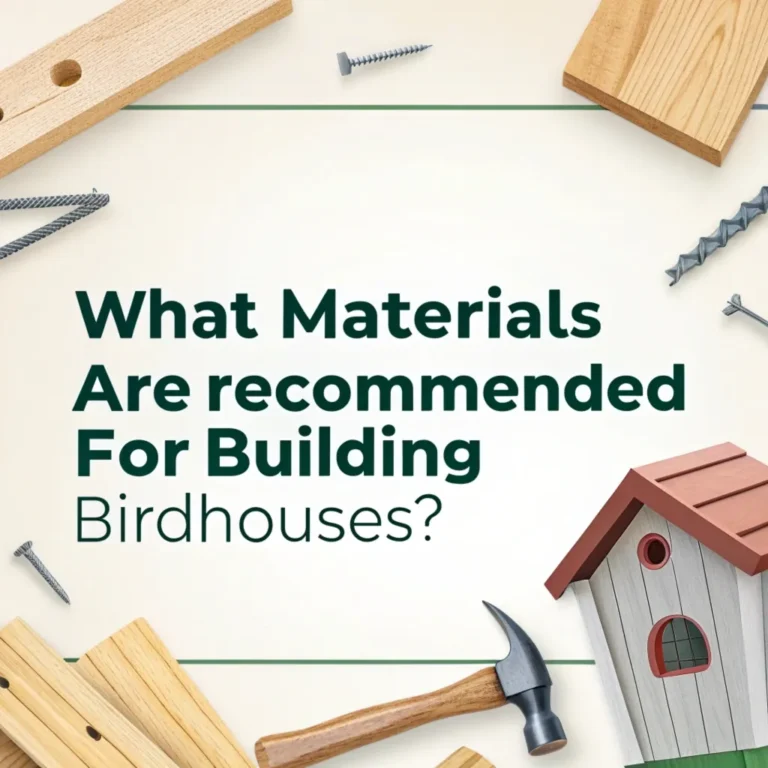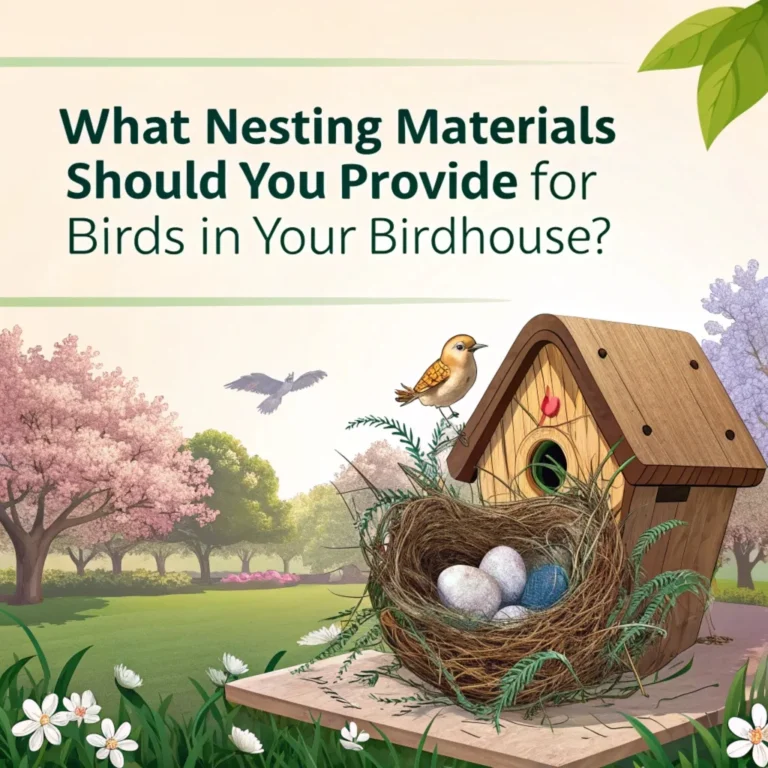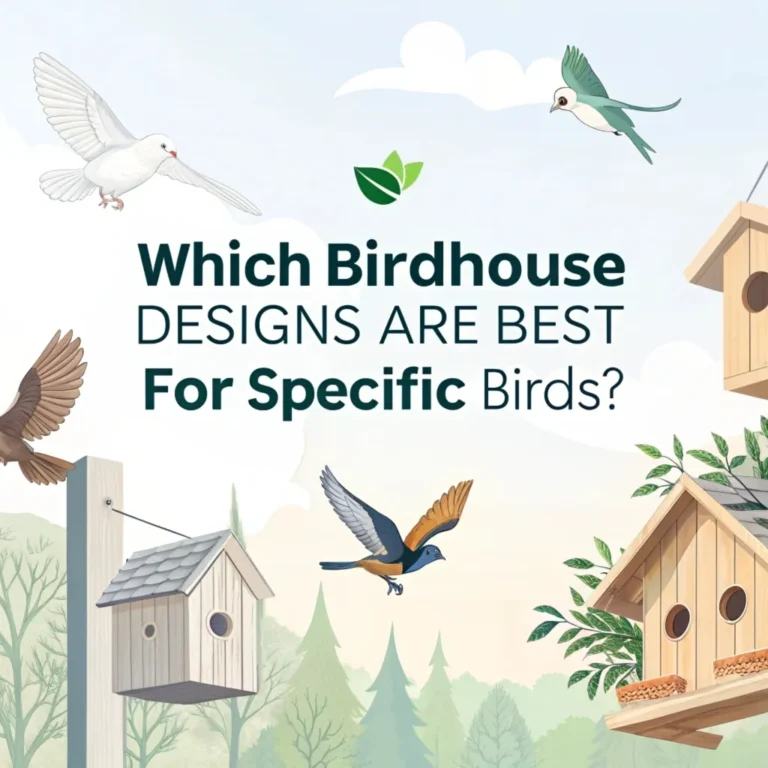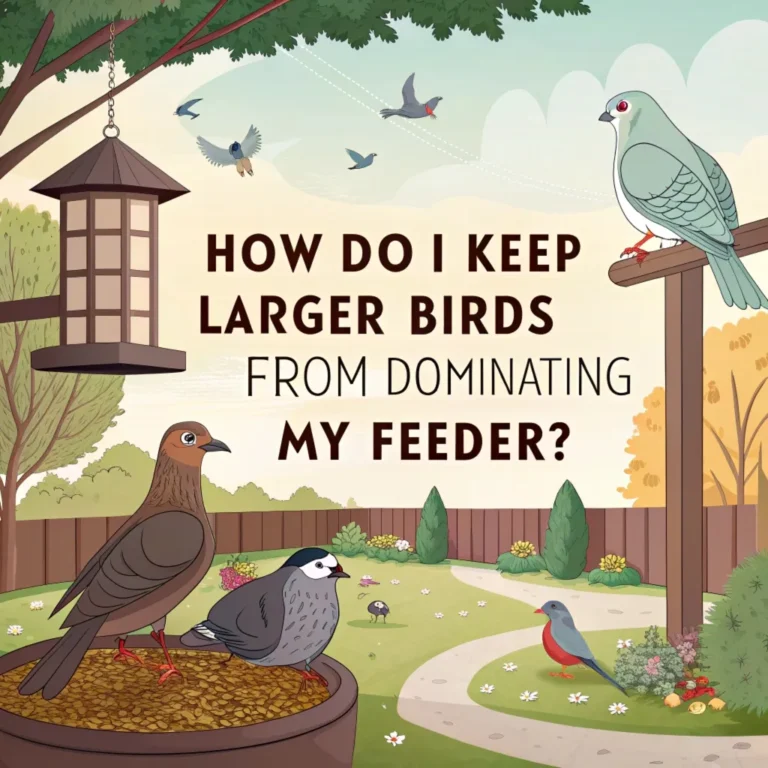What Birdhouse Designs Are Beneficial for Small Yards?
Birdhouses enhance small yards by attracting feathered visitors. This guide presents effective birdhouse designs for limited spaces.
You will learn about various styles that fit compact outdoor areas. These designs cater to different bird species and yard layouts.
Discover how to create inviting habitats for local birds in your small yard. The right birdhouse can transform your space into a vibrant bird sanctuary.
Key Takeaways: Birdhouse Designs for Small Yards

- Choose compact designs that fit limited spaces
- Select wood as the primary material for birdhouses
- Avoid perches to deter predators
- Ensure proper hole sizes for target bird species
- Install multiple houses to attract diverse birds
- Consider hanging options for space-saving solutions
- Maintain proper spacing between houses
- Clean birdhouses annually for bird health
- Use earth tones to blend with surroundings
- Provide proper ventilation and drainage in designs
Classic Wooden Birdhouse
The classic wooden birdhouse remains a top choice for small yards. This design features a rectangular shape with a sloped roof. Wood provides insulation and mimics natural nesting cavities.
Choose untreated wood for the interior to aid bird grip. Paint the exterior with earth tones to blend with the environment. Ensure a snug entrance hole between 1 and 1.25 inches in diameter to keep out unwanted guests.
Proper placement of classic wooden birdhouses is crucial for attracting birds. Position the house 5 to 10 feet above the ground, facing away from prevailing winds.
Secure it to a sturdy pole or tree trunk to provide stability. Avoid placing the birdhouse near bird feeders to prevent territorial conflicts and reduce the risk of predators.
For optimal results, consider the specific needs of local bird species when designing or selecting a classic wooden birdhouse. Research common backyard birds in your area and tailor the house dimensions accordingly.
Open-Front Nest Box
Open-front nest boxes cater to birds like robins and blue jays. These boxes have a half-open front instead of a small entrance hole.
Place these boxes in secluded spots with good access. Ideal locations include walls covered with climbing plants. This design offers protection while allowing birds easy entry and exit.
Open-front nest boxes provide a unique opportunity to observe nesting behaviors up close. Position these boxes near windows or patios for an intimate birdwatching experience.
Ensure the box is sheltered from direct sunlight and rain to protect the nest and its inhabitants.
Remember to respect the birds’ privacy during nesting season to avoid disturbing the parents or young.
Hanging Birdhouse

Hanging birdhouses save space in small yards. These houses hang from trees or brackets instead of mounting on posts. This design offers better protection from predators and keeps the house cooler.
Regularly check the attachments to ensure the house remains secure. Hanging houses work well for species like chickadees and wrens.
Proper balance is essential for hanging birdhouses. Use sturdy materials like metal chains or strong cords to suspend the house.
Ensure the house remains level to prevent eggs or nestlings from rolling out. Consider adding a baffle above the birdhouse to deter squirrels and other climbing predators.
Adjust the height of hanging birdhouses based on the target species and your viewing preferences.
Cup-Shaped Terracotta Nest
Cup-shaped terracotta nests attract swallows to small yards. These nests mimic the natural shape of swallow nests.
Attach these cups to walls or under roof overhangs. Leave at least 2.4 inches of space above for easy bird access. If installing multiple cups, space them at least 3.2 feet apart.
Terracotta nests offer excellent insulation properties, keeping the interior cool in summer and warm in winter.
This material also provides good ventilation, crucial for the health of nestlings. Consider adding a small amount of nesting material inside the cup to encourage swallows to use the artificial nest.
Regularly inspect terracotta nests for cracks or damage to ensure they remain safe for bird use.
Hummingbird Nest Builder

Hummingbird nest builders offer a unique option for tiny yards. These structures feature two spikes around which hummingbirds build nests.
The spikes secure the nest against wind. Include some nesting material behind a wire grate to attract hummingbirds. This design supports the smallest of garden visitors.
Hummingbird nest builders require specific placement for success. Position these structures near nectar-rich flowers or hummingbird feeders to increase visibility.
Install the nest builder in a sheltered location, protected from strong winds and direct sunlight. Avoid areas with high foot traffic to provide a peaceful nesting environment.
Patience is key when using hummingbird nest builders, as it may take time for birds to discover and utilize these structures.
Small Chickadee House
Chickadee houses require specific dimensions for success. The entrance hole should measure 1.125 inches in diameter.
Position the hole 4 to 6 inches above the box floor. The entire box should stand about 8 inches tall and 5 inches deep. Place these houses 5 to 15 feet above ground level.
Chickadees prefer houses placed in wooded areas or near the edge of your yard. These birds appreciate a mix of sun and shade throughout the day.
Install the house before the breeding season begins in early spring to give chickadees time to discover and claim the nesting site.
Consider adding a predator guard below the chickadee house to deter climbing animals.
A-Frame Birdhouse
A-frame birdhouses offer a compact and attractive design. This style works well for various small birds including bluebirds and swallows.
The sloped roof provides excellent rain protection. Mount these houses on poles to deter climbing predators. The simple design allows for easy cleaning and maintenance.
A-frame birdhouses blend well with various architectural styles, making them a popular choice for small yards.
The triangular shape not only adds visual interest but also provides efficient use of materials. Consider painting the exterior with non-toxic, water-based paints in natural colors to enhance durability and aesthetics.
Ensure proper ventilation by adding small holes near the roof peak of A-frame birdhouses.
Multi-Compartment Birdhouse
Multi-compartment birdhouses maximize space in small yards. These structures house several bird families in one unit. Design each compartment with the proper dimensions for target species.
Ensure adequate spacing between compartments to prevent territorial disputes. This option works well for social birds like purple martins.
Multi-compartment birdhouses require careful planning to accommodate different species. Research the nesting preferences of local birds and design compartments accordingly. Include varying entrance hole sizes to attract a diverse bird population.
Regular maintenance is crucial for these complex structures to ensure all compartments remain clean and safe.
Consider installing a predator guard on the pole supporting multi-compartment birdhouses to protect multiple nests simultaneously.
Eco-Friendly Recycled Birdhouse
Recycled material birdhouses add a unique touch to small yards. Convert items like old funnels, tin cans, or wooden crates into bird homes.
Ensure these DIY houses meet proper size and safety requirements. Add proper drainage and ventilation to recycled designs. These houses blend functionality with eco-conscious aesthetics.
Upcycling household items into birdhouses not only reduces waste but also creates one-of-a-kind garden features.
When designing recycled birdhouses, prioritize bird safety by avoiding sharp edges or toxic materials. Apply a non-toxic sealant to protect the structure from weather damage and ensure longevity.
Engage children in creating recycled birdhouses to foster an appreciation for nature and conservation.
Window-Mounted Birdhouse
Window-mounted birdhouses bring birds up close in limited spaces. These houses attach directly to window panes with suction cups.
Choose designs with one-way mirror fronts to observe birds without disturbing them. Ensure a tight seal to prevent drafts. This option provides an intimate birdwatching experience in the smallest of yards.
Window-mounted birdhouses offer a unique perspective on bird behavior. Position these houses on quieter windows away from high-traffic areas inside your home.
Consider adding UV decals to the exterior of the window to prevent bird collisions. Clean the window and birdhouse regularly to maintain clear visibility and hygiene.
Patience is key when installing window-mounted birdhouses, as birds may take time to adapt to this new nesting location.
FAQs About Birdhouse Designs for Small Yards
What is the best material for birdhouses in small yards?
Wood stands as the best material for birdhouses. It provides natural insulation and mimics tree cavities. Choose untreated wood for the interior to aid bird grip. Paint or stain the exterior with earth tones for weather protection and camouflage.
How do I attract birds to birdhouses in a small yard?
Attract birds by placing houses in quiet areas away from busy spots. Provide proper hole sizes for target species. Keep houses clean and maintain them annually. Offer food and water sources nearby to create a complete habitat.
Can I put multiple birdhouses in a small yard?
Yes, you can install multiple birdhouses in a small yard. Space houses for the same species at least 20 feet apart. Different species can have houses closer together. Vary house designs to attract diverse bird populations.
How often should I clean birdhouses in my small yard?
Clean birdhouses annually, preferably in late fall or early spring. Remove old nesting material and scrub the interior with a mild soap solution. Rinse thoroughly and allow to dry completely before closing the house.
What features should I look for in a birdhouse for a small yard?
Look for compact designs with proper ventilation and drainage. Ensure the entrance hole size matches target species. Choose houses with easy-clean features like hinged sides or roofs. Avoid perches, which can aid predators.
Birdhouses bring nature’s beauty to small yards. By choosing the right designs, you create safe havens for local birds. These structures support biodiversity and offer endless enjoyment. Select birdhouses that fit your space and target species for the best results. With proper care, your small yard can become a thriving bird sanctuary.

Luna is the passionate founder and author of Birds and You, a website dedicated to sharing her love for birds with fellow enthusiasts. Through her engaging articles and guides, she aims to educate and inspire others to explore the fascinating world of birds. When she’s not writing, you can find Luna observing birds in their natural habitats or sharing beautiful bird photography on Pinterest. Join her on this journey to celebrate and protect our feathered friends!







